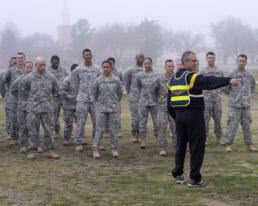Story by: 1st Lt. Alicia Lacy
Posted: March 3, 2015
 1st Lt. Alicia Lacy
1st Lt. Alicia Lacy
Staff Sgt. Anthony Delagarza, a Master Fitness Trainer Course instructor, gives directions to soldiers before a round of guerrilla drills March 3, 2015, at Fort Hood, Texas, as part of the Master Fitness Trainer Course. About 20 National Guard and active duty Army soldiers began the final two weeks of training to become master fitness trainers to act as special advisers to unit commanders to facilitate physical training. (Air National Guard photo by 1st Lt. Alicia M. Lacy/Released)
FORT HOOD, Texas – Master Fitness Trainer Course instructors from the 2nd Battalion, 136th Regiment, Regional Training Institute, Texas Army National Guard, continue to support the one-Army-school system through their multi-component training class.
The instructors hosted the fourth iteration of the course Feb. 22 – March 6, 2015, at Fort Hood.
“Right now, the Army is working toward a one-Army-school system, which basically means that any soldier from any component can go to a school being taught by a different component,” said Command Sgt. Maj. Robert Balderston, commandant for the Texas Army National Guard training institute. “This course validates the principle that it’s a joint effort between components.”
Traditionally, National Guard, active duty and Reserve soldiers attended the two-week, in-residence, Phase II portion of the training class at the Texas National Guard’s headquarters at Camp Mabry in Austin; however, for this iteration the course tested the Fort Hood location.
“Fort Hood’s III Corps is providing resources and we’re providing instructors, so it’s a win-win for everybody because they’re able to get their soldiers trained and we’re able to validate the one-Army-school system concept,” Balderston said about soldiers receiving training across components.
The course had a mix of five National Guard soldiers from Texas, Louisiana, Florida and Missouri, and 15 active duty soldiers from numerous bases in Texas and Colorado.
The multi-component mixture in the class supported the total force Army concept, allowing soldiers from all components to work and train together.
“I look at it as a one team, one fight,” said Sgt. Jose Hamilton, a nodal network systems operator-maintainer with the 86th Expeditionary Signal Battalion based at Fort Bliss. “The instructors are Guard and they still come in with that military bearing ... you would expect from someone being in the Army, period.”
The National Guard-led course is only one of five Master Fitness Trainer Course sites in the entire country, charged with training National Guard, active duty and Reserve soldiers to be master fitness trainers who can conduct physical readiness training for their units.
“The course is getting us ready to train our units on how to do the correct PRT to help our soldiers get better at fitness all around,” said Sgt. 1st Class Christi Stephens, the readiness noncommissioned officer for the 249th Transportation Company, Texas Army National Guard. “When we do PRT, we’ll do it the right way, so even if we have them for just one day and we do one hour, we can do it right and have that precision we’re supposed to have.”
Following the successful completion of the academically intense, two-week distance learning course and the two-week in-residence course, which is largely physical, the soldiers will be advisers to their unit commanders on all things PRT, as well as educating their peers on performance, nutrition, fitness and readiness.
While working through the training modules, soldiers learned about the principles of PRT – precision, progression and integration – that aid in reconditioning and reducing injuries.
“You’ve got to earn your precision before you can go to the progression phase of these movements,” said Sgt. 1st Class Shelley Horner, an MFTC instructor and the course’s noncommissioned officer in charge. “Injury prevention is one of the biggest things for MFTC. We are very specific. We make sure the students really know the standard and are able to take that back to their units and train the trainer.”
Master Fitness is part of the Army’s effort to increase soldier physical readiness, reduce injuries and standardize unit training by preparing soldiers for the physical challenges of fulfilling the mission in complex environments, while facing a range of threats, according to the Army Physical Readiness Training Field Manual 7-22.
The MFTC is one of several courses offered by the RTI that is available to all soldiers regardless of component.